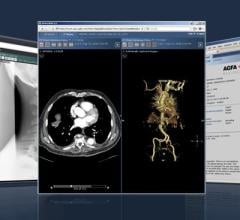
Evan Kaminer, M.D., and Freddie Adorno, Nyack's manager of enterprise imaging informatics, collaborating on an Intelligent Worklist. (Photo courtesy of Shay Frey)
Nyack Hospital is a 375-bed community acute care medical and surgical hospital that was founded in 1895 and is located in Rockland County, N.Y. Its mission is to provide competent, innovative and accessible emergency and acute care services to the residents of Rockland County and surrounding areas. Aa a partner with Touro College of Osteopathic Medicine, it provides clinical rotations to medical students.
In this article, we discuss the importance of quality workflows with Evan Kaminer, M.D., chairman of radiology at Nyack Hospital.
Q: What is your current reading environment?
A: At the hospital we have a picture archiving and communication system (PACS) supplied from a single vendor. We have private offices with a PACS from a different vendor. In the hospital there are two reading workstations placed side-by-side but not integrated.
Q: What trends are you experiencing with respect to quality initiatives?
A: At Nyack, as at other hospitals, there is the trend to improve quality processes, workflow and reporting. As such, we have designed a number of workflows with specific metrics to be met. In some cases the metrics are then reported to the government.
Here are some examples:
• Read stroke cases within 30 minutes;
• Get studies out more efficiently to help decrease the length of patient stay in the hospital; and
• Improve the report turnaround time for emergency cases through identification and prioritization.
Workflows and processes such as these have a real impact to the patient and to the hospital.
Q: What is a specific feature that has been most important to the workflow?
A: Our greatest challenge was flagging the emergent and urgent cases. Like many hospitals, we are flooded with cases marked STAT. For example, every study done in the emergency room is marked STAT, even if the case has been reviewed by the ER physician or over-night radiologist. The technologists had a manual process for identifying high-priority cases, but the process was time-consuming and prone to error.
Our workflow intelligence solution has automated this process by integrating information about the patient’s location, exam type, ordered priority and time of day to assign a priority number. The highest priority cases are read first.
However, priority is not static. There is an escalation model and a de-escalation model, which allows for change as new data is received. Studies can increase in priority if not read in preprogrammed times. They can decrease in priority if a preliminary report is generated.
Q: Are there other features that you have found valuable?
A: Yes, there are a number of valuable features.
The ability to move the study prioritization model to the administrative level is an important feature. In the past, radiologists were allowed to decide how they would set up their individual worklists. This has caused problems making sure urgent cases are read in a timely manner. Now, using the flexible rules engine provided in our workflow intelligence solution, I (as the chairman) am able to decide how cases are prioritized and thus the order in which the cases are read.
There is an added benefit to the radiologists who do not frequently come to the hospital. In the past they have struggled to remember workflows and prioritization models, but now rely on the system to organize their reading priority for them. This helps us stay compliant with our service agreements with the hospital.
Additionally, with workflow intelligence (WI) our staff no longer wastes valuable time searching through numerous worklists, trying to locate urgent cases. Now the workflow intelligence solution advises them if a case is at risk to miss a read time requirement so they can then take appropriate action. Notification can come via pop-up alert, e-mail and even SMS text message. The notification process also has an escalation model that includes radiologists and support staff.
With workflow intelligence we are able to help ICU discharge patients faster. By putting the ICU studies at the top of the worklist, the radiologists can read the studies sooner and free up the ICU beds faster. The system also allows manual prioritization if a patient is waiting to be discharged and needs a priority reading.
Q: Can you describe the difference in your workflow prior to and after the implementation of the workflow intelligence solution?
A: There are so many different facets to it. The system can touch so many different aspects in a workflow that it’s hard to encompass it all into one statement. From the radiologist’s perspective, we moved away from filtered and sorted lists into an intelligent list. In the past we had several filtered lists that we sorted so that the cases were read in the best order. Now workflow intelligence determines the order using rules that we can modify over time. I no longer have to move around lists trying to make sure cases are read in the optimal order. I have one list that I create at the start of the day and WI prioritizes it for me. The biggest difference, however, is that the system will notify me and my partners if a case is missed, allowing us to jump on the error pospectively rather than in a Root Cause Analysis meeting weeks later.
Q: You mean to show that there’s increased productivity …
A: Yes, we are more productive. However, from my point of view I measure success by the exceptions. It’s the cases that we fail to read in a timely manner that cause me the greatest distress. It only takes one delayed reading with a bad outcome to lead to a disaster. While we focus on metrics and policies, ultimately we’re dealing with people’s lives.
Case study supplied by McKesson Corp.



 May 24, 2024
May 24, 2024 








